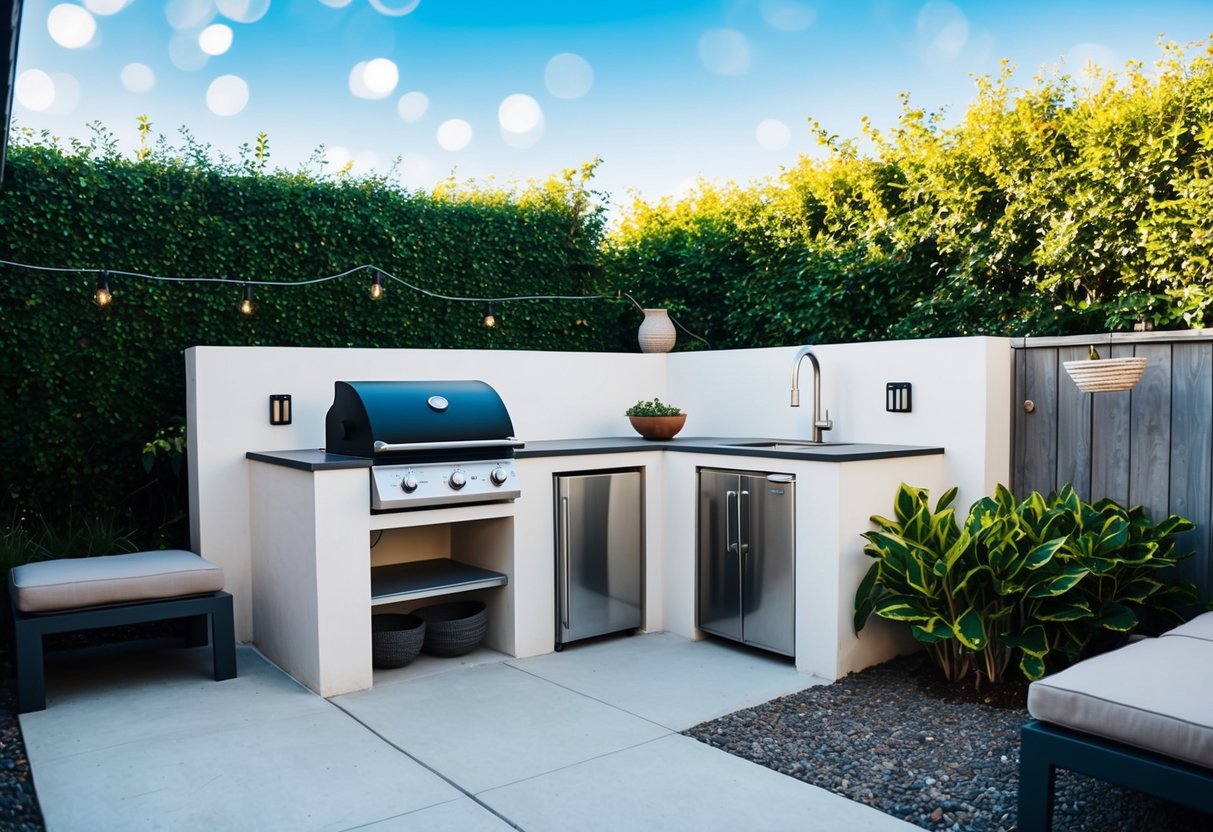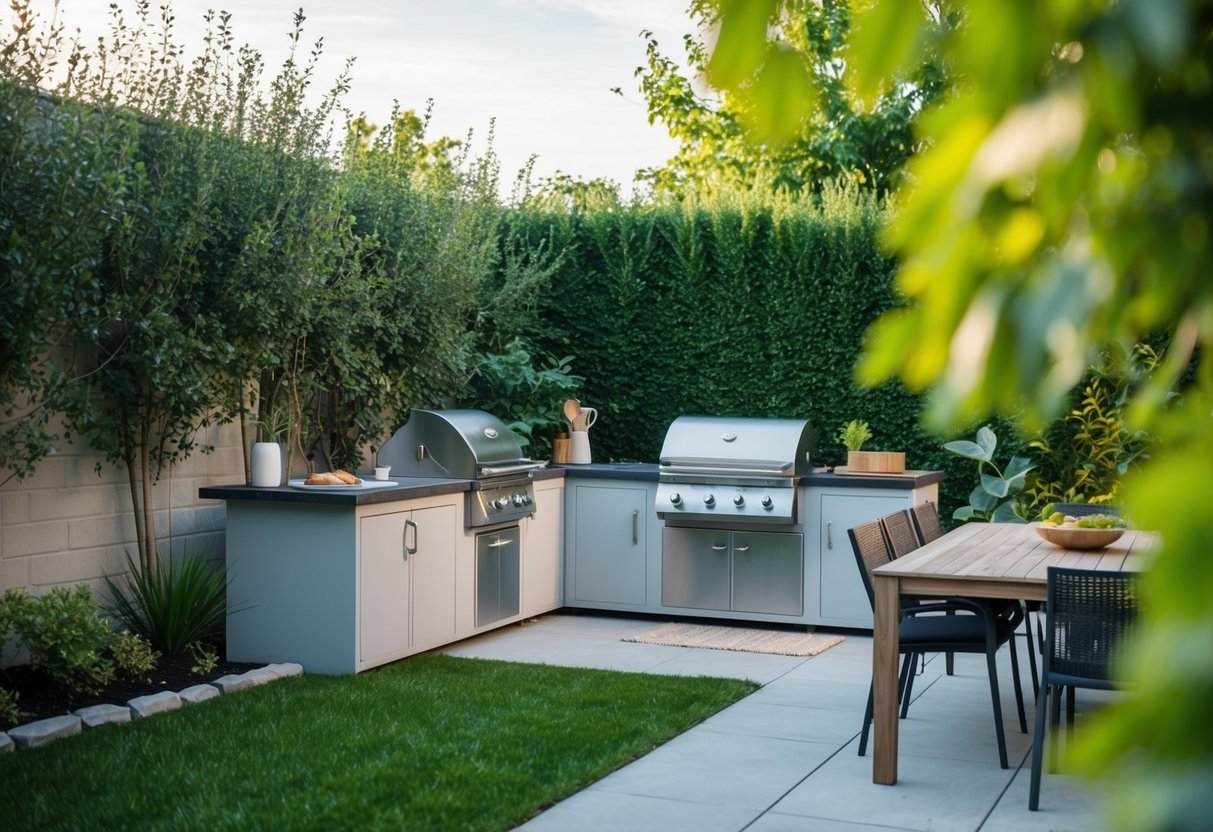
Incorporating Cooking Features

When designing a low-cost outdoor kitchen, focusing on core cooking appliances such as pizza ovens and barbeques can add versatility and enjoyment to the space. These features not only enhance culinary possibilities but also provide unique dining experiences.
Pizza Ovens
A pizza oven can transform an outdoor kitchen into an authentic pizzeria. Whether it’s a traditional brick design or a more portable metal model, these ovens heat up quickly and cook pizzas to perfection. They can also bake bread and roast vegetables, adding to their usefulness. Consider materials; while brick retains heat well, metal ovens tend to be lighter and more budget-friendly.
Placement is essential. Situate the pizza oven where it can be easily accessed without disrupting the flow of the kitchen. Ensure there’s adequate ventilation, particularly if the oven utilizes wood or charcoal. It’s also practical to have a prep area nearby for dough and toppings.
Barbeques and Smokers
A barbeque is the centerpiece of many outdoor kitchens, offering the ability to grill a variety of foods. It’s crucial to select a model that suits cooking habits, whether it’s a gas, charcoal, or electric barbeque. Smokers, on the other hand, allow for low and slow cooking, enhancing flavors through wood smoke.
Both barbeques and smokers need to be positioned in a well-ventilated area. A modest shelter could help protect them from the elements, extending their lifespan. Don’t forget to allocate space for storing fuel or wood chips and consider a brief resting place for cooked food to avoid constant trips indoors.
Outdoor Kitchen Islands
Outdoor kitchen islands offer a practical and stylish solution for bringing indoor cooking convenience to the backyard. Essential considerations include thoughtful design for efficiency and selecting materials that can withstand outdoor conditions.
Design and Functionality
Design plays a crucial role in maximizing an outdoor kitchen island’s usability. Aligning the layout with cooking habits helps in organizing essential features such as grills, sinks, and storage. Centralizing the grilling station can create a focal point for social gatherings, while strategic placement of countertops enhances prep space.
Including amenities like seating and lighting contributes to a comfortable cooking and dining experience. Space planning should account for foot traffic, ensuring there’s adequate room for guests to move around without disrupting the cook’s workflow.
Materials and Durability
Selecting durable materials is vital for building a long-lasting outdoor kitchen island. Stainless steel is a popular choice for its resistance to rust and ease of cleaning, making it ideal for appliances. For countertops, options like granite or concrete are favored due to their heat resistance and sturdiness.
Weather resistance is crucial, as exposure to elements can degrade some materials. Specifically, the cabinetry can benefit from marine-grade plywood or polymer, which offer enhanced protection against moisture. Material selection should balance aesthetics with practical concerns to ensure longevity without sacrificing style.
Enhancing with Amenities
In a low-cost outdoor kitchen, adding thoughtful amenities can significantly improve functionality and style. Introducing elements like a pergola or a fire pit can transform the space into a comfortable and inviting area.
Adding a Pergola
A pergola can define the outdoor kitchen area. It offers shade and adds a touch of elegance. Crafted from materials such as wood, metal, or vinyl, a pergola provides versatility in design and maintenance choices.
Choosing the right size and placement is crucial. A properly sized structure should cover the cooking area and allow easy movement. Integrating climbing plants or hanging lights can enhance the pergola’s aesthetic appeal, creating a cozy ambiance.
For those on a budget, there are DIY options. Prefabricated kits are available, offering a more affordable alternative to custom builds. Selecting weather-resistant materials can ensure long-lasting durability without frequent upkeep. Installing a pergola not only elevates the visual appeal but also enhances the practicality of the outdoor kitchen.
Integrating a Fire Pit
A fire pit can be a focal point in an outdoor kitchen, offering both warmth and an inviting atmosphere. Available in various styles, fire pits can be built-in or portable, catering to different preferences and spaces.
Selecting the right fuel type is essential. Options include wood, propane, or natural gas, each with its own benefits and considerations. Safety is paramount; therefore, ensuring proper placement away from flammable structures and using fire guards is important.
Installing a seating area around the fire pit encourages social gatherings, creating a cozy setting for evening meals. Opting for durable materials like stone or metal can increase the fire pit’s longevity. By integrating a fire pit, the outdoor kitchen becomes a hub for relaxation and enjoyment.